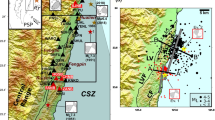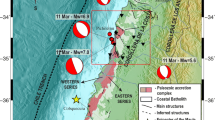Abstract
The Koyna-Warna region in western India is well known around the globe for recurrent reservoir-triggered seismicity soon after the impoundment of the Koyna and Warna reservoirs. The seismicity pattern delineates two distinct seismic zones, Koyna Seismic Zone (KSZ) and Warna Seismic Zone (WSZ). To understand the seismic potential of the region, we estimated the strain budget by analysing the published GPS velocities and earthquake catalogue of the region. Although the KSZ and WSZ are separated by ~25 km only, the rate of strain accumulation in the former (2.55E+16 Nm/year) is estimated to be ~11 times larger when compared to the latter (2.29E+15 Nm/year). However, KSZ releases only ~20% of the accumulated energy per year, whereas, WSZ releases most of the accumulated energy in the form of earthquakes. Best fitting elastic dislocation model for KSZ also shows a left lateral slip of 0.8 mm/year and the fault plane dips at ~77° in NW direction. The distribution of strain accumulation and release rates in the two regions may be attributed to significant spatial variability in the medium properties such as density, elastic constants and fracture density. This proposition is supported by other geophysical studies in the region. A density model constructed from Airborne Gravity Gradiometry (AGG) data also shows relatively higher average density for KSZ compared to the WSZ. The strain budget of the region suggests that the earthquake activity in KSZ may continue for a longer time whereas it may diminish in the WSZ in the near future. Based on the gross strain estimates, the KSZ has accumulated enough strain post the 1967 M6.3 Koyna earthquake to generate an event of Mw5.8, provided the accumulated strain is released in a single event. The seismic hazard scenario in terms of peak ground acceleration (PGA) due to a potential Mw5.8 event is estimated using the stochastic simulation (SS) technique. The simulated PGA at a radial distance of ~40km from the source zone is estimated to range between 0.09 and 0.26g with an expected intensity of V–VII.








Similar content being viewed by others
References
Aktug B, Ozener H, Dogru A, Sabuncu A, Turgut B, Halicioglu K, Yilmaz O, Havazli E (2016) Slip rates and seismic potential on the East Anatolian Fault System using an improved GPS velocity field. J Geodyn 94–95:1–12. https://doi.org/10.1016/j.jog.2016.01.001
Anderson JG, Wesnousky SG, Stirling MW (1996) Earthquake size as a function of fault slip rate. Bull Seismol Soc Am 86:683–690
Atkinson GM, Boore DM (2006) Earthquake ground-motion prediction equations for Eastern North America. Bull Seismol Soc Am 96(6):2181–2205. https://doi.org/10.1785/0120050245
Barman P, Ray JD, Kumar A, Chowdhury JD, Mahanta K (2014) Estimation of present-day inter-seismic deformation in Kopili fault zone of north-east India using GPS measurements. Geom Nat Hazards Risk 5705(2):1–14. https://doi.org/10.1080/19475705.2014.983187
BIS (2002) Indian standard criteria for earthquake resistant design of structure. Part 1 resistant provision and buildings. Bureau of Indian Standards, New Delhi
Cardozo N, Allmendinger RW (2009) SSPX—a program to compute strain from displacement/velocity data: Computers and Geosciences, 35, 1343–1357. https://doi.org/10.1016/j.cageo.2008.05.008
Chaterjee GC, Guha SK (1968) The problem of origin of high temperature springs of India. Proc Symp (II), 23rd Int Geol Cong, Prague 17:141–149
Cohen SC (1999) Numerical models of crustal deformation in seismic zones. Adv Geophys 41:134–231
Cronin V, Resor P (2019) GPS and infinitesimal strain analysis, GETSI’s Earth-focused Modules for Undergraduate Classroom and Field Courses, https://serc.carleton.edu/168230. Accessed November 2020
Duncan RA, Pyle DG (1988) Rapid eruption of Deccan flood basalts at the Cretaceous/Tertiary boundary. Nature 333:841–843
G.S.I (1968) A geological report on the Koyna earthquake of 11 the December, 1967, Satara District, Maharashtra State. Report submitted by Officers of the Geological Survey of India, March 1968, 273.
Gahalaut VK, Gahalaut K, Joshi KC, Sreejith KM, Agrawal R, Yadav RK, Mohanalakshmi CH, Naidu MS, Rao VR (2018) Geodetic constraints on tectonic and anthropogenic deformation and seismogenesis of Koyna–Warna region, India. Bull Seismol Soc Am 108(5B):2933–2942
Goswami D, Akkiraju V, Misra S, Roy S, Singh SK, Sinha A, Gupta H, Bansal BK, Nayak S (2017) Rock strength measurements on Archaean basement granitoids recovered from scientific drilling in the active Koyna seismogenic zone, western India. Tectonophysics:712–713
Guha SK, Gosavi PD, Varma M, Agarwal SP, Padale JG, Marwadi SC (1968) Recent seismic disturbances in the Koyna Hydroelectric Project, Maharashtra, India. Report, Central Water and Power Research Station, India
Gupta HK (2017) Koyna, India, an ideal site for near field earthquake observations. J Geol Soc India 90:645–652
Gupta HK (2019) Koyna, India, an ideal site for near field earthquake observations. Proc Indian Natn Sci Acad 85 No 2:469–480. https://doi.org/10.1007/S12594-017-0771-2
Gupta S, Gupta ID (2004) The prediction of earthquake peak ground acceleration in Koyna region, India, 13th World Conference on Earthquake Engineering, Vancouver, B.C., Canada, Paper No. 1437
Gupta H, Narain H, Rastogi BK, Mohan I (1969) A study of the Koyna earthquake of December 10, 1967. Bull Seismol Soc Am 59(3):1149–1162
Gupta HK, Rao RUM, Srinivisan R, Rao GV, Reddy GK, Dwivedy KK, Banerjee DC, Mohanty R, Satyasaradhi YR (1999) Anatomy of surface rupture zones of two stable continental region earthquakes, 1967 Koyna and 1993 Latur. India Geophys Res Lett 26(13):1985–1988
Hackl M, Malservisi R, Wdowinski S (2009) Strain rate patterns from dense GPS networks. Nat Hazards Earth Syst Sci 9:1177–1187. https://doi.org/10.5194/nhess-9-1177
Hanks TC, Kanamori H (1979) A moment magnitude scale. J Geophys Res 84(5):2348–2350. https://doi.org/10.1029/JB084iB05p02348
IS 1893 (1962) Recommendations for earthquake resistant design of structures. Bureau of Indian Standards, N Delhi
Iyengar RN, Raghu Kanth STG (2004) Attenuation of strong ground motion in peninsular India. Seismol Res Lett 75(4):530–540. https://doi.org/10.1785/gssrl.75.4.530
Jayalakshmi S, Raghukanth STG (2016) Intra plate stresses using finite element modelling. Acta Geophys 64:1370–1390. https://doi.org/10.1515/acgeo-2016-0050
Johnston AC (1996) Seismic moment assessment of earthquakes in stable continental regions- instrumental seismicity: Geophys. J Int 124:381–414
Kaila KL, Reddy PR, Dixit M, Lazarenko M (1981) Deep crustal structure of Koyna, Maharashtra indicated by deep seismic soundings. J Geol Soc India 22:1–16
Kailasam LN, Reddy AGB, Joga Rao MV, Satyamurthy YK, Murthy BPR (1976) Deep electrical resistivity soundings in the Deccan Trap region. Curr Sci 45:9–13
Kanamori H (1983) Magnitude scale and quantification of earthquakes. Tectonophysics 93:185–199
Kolathayar S, Sitharam TG (2012) Characterization of regional seismic source zones in and around India. Seismol Res Lett 83(1):77–85
Kostrov BV (1974) Seismic moment and energy of earthquakes and seismic flow of rock. Izvestiya-Physics of the Solid Earth 1:23–40
Le Beon M, Klinger Y, Amrat AQ et al (2008) Slip rate and locking depth from GPS profiles across the southern Dead Sea Transform. J Geophys Res Solid Earth 113:11403. https://doi.org/10.1029/2007JB005280
Li J, Zhou B, Li T, Yang Y, Li Z (2020) Locking depth, slip rate, and seismicity distribution along the Daofu–Kangding segment of the Xianshuihe fault system, eastern Tibetan Plateau. J Asian Earth Sci 193:104328. https://doi.org/10.1016/j.jseaes.2020.104328
Mandal P, Rastogi BK, Sarma CSP (1998) Source parameters of Koyna earthquakes, India. Bull Seismol Soc Am 88(3):833–842
Milne J (1911) A catalogue of destructive earthquakes A.D. 7 to A.D. 1899. British Association for the Advancement of Science, Portsmouth, 1911, p 92
Motazedian D, Atkinson GM (2005) Stochastic finite-fault modeling based on a dynamic corner frequency. Bull Seismol Soc Am 95:995–1010
Narain H, Gupta HK (1968) Koyna earthquake. Nature. 217:1138–1139
Nath SK, Thingbaijam KKS (2009) Seismic hazard assessment: a holistic microzonation approach. Nat Hazards Earth Syst Sci 9:1445–1459. https://doi.org/10.5194/nhess-9-1445-2009
Rao NP, Shashidhar D (2017) Earthquake focal mechanism studies in Koyna-Warna region in the last five decades - Current understanding on tectonics and seismogenesis. J Geol Soc India 90:684–691. https://doi.org/10.1007/s12594-017-0776-7
Rastogi BK, Chadha RK, Sarma CSP, Mandal P, Satyanarayana HVS, Raju IP, Kumar N, Satyamurthy C, Nageswara Rao A (1997) Seismicity at Warna reservoir (near Koyna) through 1995. Bull Seismol Soc Am 87(6):1484–1494
Reid HF (1910) The mechanics of the earthquake, The California Earthquake of April 18, 1906, report of the State Investigation Commission, vol 2. Carnegie Institution of Washington, Washington, D.C.
Rohilla S, Ravi Kumar M, Rao NP, Satyanarayana HVS (2018) Shear-wave velocity structure of the Koyna–Warna region, Western India, through modeling of P-receiver functions. Bull Seismol Soc Am 108(3A):1314–1325
Roy S (2017) Scientific drilling in Koyna region, Maharashtra. Curr Sci 112(11):2181–2181
Roy S, Rao NP, Akkiraju VV, Goswami D, Sen M, Gupta HK, Bansal BK, Nayak S (2013) Granitic basement below Deccan traps unearthed by drilling in the Koyna Seismic zone, Western India. J Geol Soc India 81:289–290
Sairam B, Singh AP, Ravi Kumar M (2018) Comparison of earthquake source characteristics in the Kachchh Rift Basin and Saurashtra horst, Deccan Volcanic Province, western India. J Earth Syst Sci 127:55
Sandwell DT (2001) Elastic solutions for strike-slip faulting. Unpublished class note, https://topex.ucsd.edu/geodynamics/. Accessed June 2021
Saragoni GR, Hart GC (1973) Simulation of artificial earthquakes. Earthq Eng Struct Dyn 2(3):249–267. https://doi.org/10.1002/eqe.4290020305
Savage JC, Burford RO (1973) Geodetic determination of relative plate motion in central California. J Geophys Res 78:832–845
Schulte SM, Mooney WD (2005) An updated global earthquake catalogue for stable continental regions—reassessing the correlation with ancient rifts. Geophys J Int 161:707–721
Segall P (2010) Earthquake and volcano deformation. Princton University Press, p 456
Sharma B, Teotia SS, Kumar D (2007) Attenuation of P, S, and coda waves in Koyna region. India J Seismol 11:327–344. https://doi.org/10.1007/s10950-007-9057-z
Shashidhar D, Rao NP, Gupta HK (2011) Waveform inversion of broad-band data of local earthquakes in the Koyna–Warna region, western India. Geophys J Int 185(1):292–304
Shashidhar D, Mallika K, Mahato C, Maity BS, Sudheer K, Satyanarayana HVS, Purnachandra Rao N, Raghavan RV, Sarma ANS, Murthy YVVBSN, Gowri Shankar U, Narsingarao D, Uma Anuradha M (2019) A catalogue of earthquakes in the Koyna-Warna region, Western India (2005–2017). J Geol Soc India 93:7–24. https://doi.org/10.1007/s12594-019-1115-y
Smith-Konter BR, Sandwell DT, Shearer P (2011) Locking depths estimated from geodesy and seismology along the San Andreas fault system: implications for seismic moment release. J Geophys Res 116:B0640
Tiwari VM, Mishra DC (1999) Estimation of effective elastic thickness from gravity and topography data under the Deccan volcanic province, India, Earth planet. Sci Lett 171:189–299
Tiwari VM, Rao MBSV, Mishra DC (2001) Density inhomogeneities beneath Deccan volcanic province, India as derived from gravity data. J Geodyn 31:1–17
Vallage A, Bollinger L (2019) Testing fault models in intraplate settings: a potential for challenging the seismic hazard assessment inputs and hypothesis? Pure Appl Geophys 177:1879–1889. https://doi.org/10.1007/s00024-019-02129-z
Wells DL, Coppersmith KJ (1994) New empirical relationships among magnitude, rupture length, rupture width, rupture area, and surface displacement. Bull Seismol Soc Am 84(4):974–1002
Yadav R, Tiwari VM (2018) Numerical simulation of present-day tectonic stress across the Indian subcontinent. Int J Earth Sci 107:2449–2462. https://doi.org/10.1007/s00531-018-1607-9
Acknowledgements
We acknowledge the support provided by Secretary, Ministry of Earth Sciences, for carrying out the studies under the Koyna Scientific Drilling Programme. The manuscript benefited from discussions with Deepjyoti Goswami. We thank Director, National Centre for Seismology, New Delhi, for extending facilities to carry out the analyses at BGRL and encouraging the study. Thomas Braun and the anonymous reviewers are sincerely acknowledged, whose comments helped in improving the quality of the current manuscript significantly.
Author information
Authors and Affiliations
Corresponding author
Additional information
Publisher’s note
Springer Nature remains neutral with regard to jurisdictional claims in published maps and institutional affiliations.
Rights and permissions
About this article
Cite this article
Sutar, A.K., Roy, S. & Tiwari, V.M. Revisiting the Koyna-Warna seismic zone: strain budget, present-day potential and associated hazard. J Seismol 25, 1265–1279 (2021). https://doi.org/10.1007/s10950-021-10024-1
Received:
Accepted:
Published:
Issue Date:
DOI: https://doi.org/10.1007/s10950-021-10024-1




